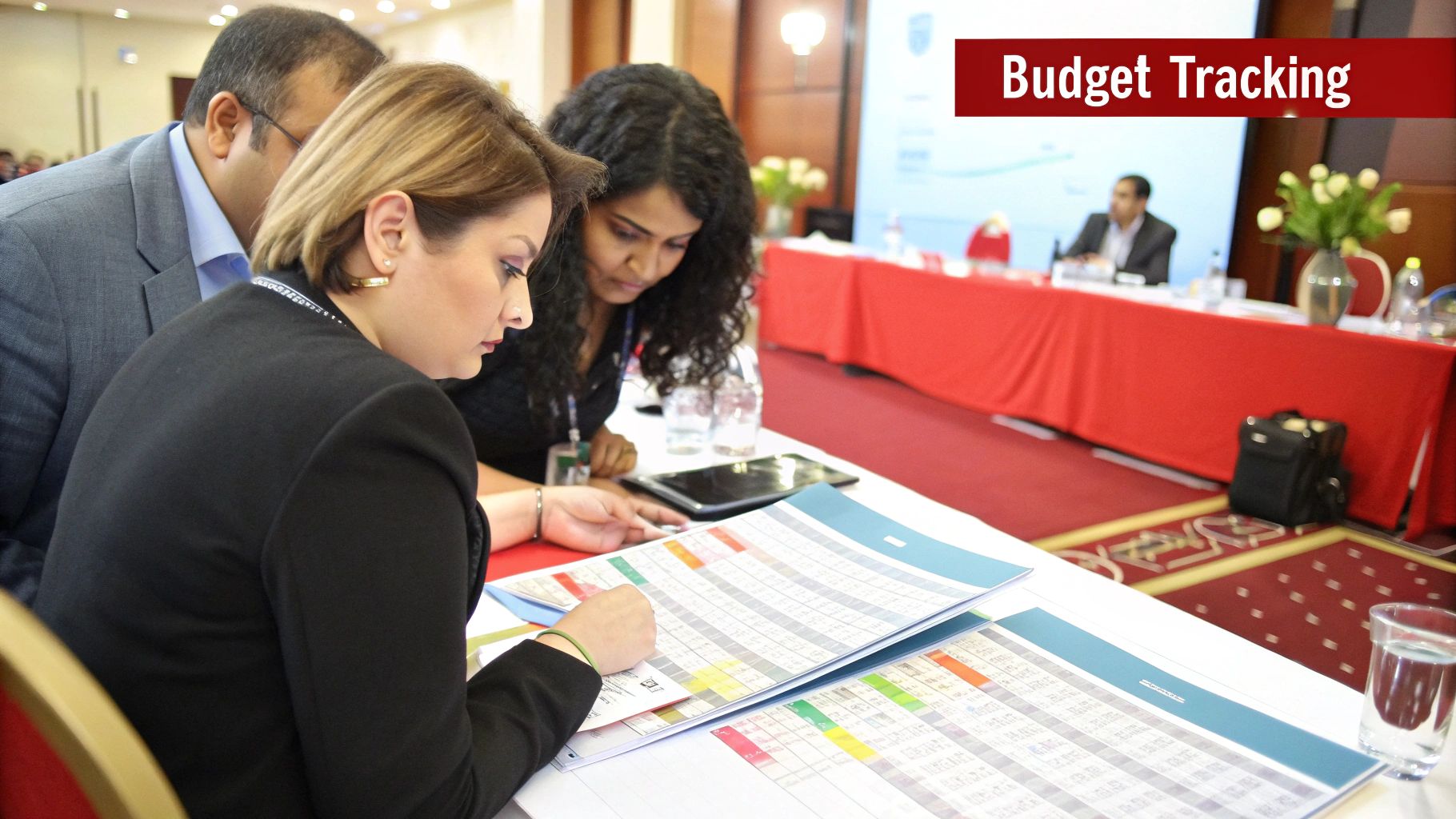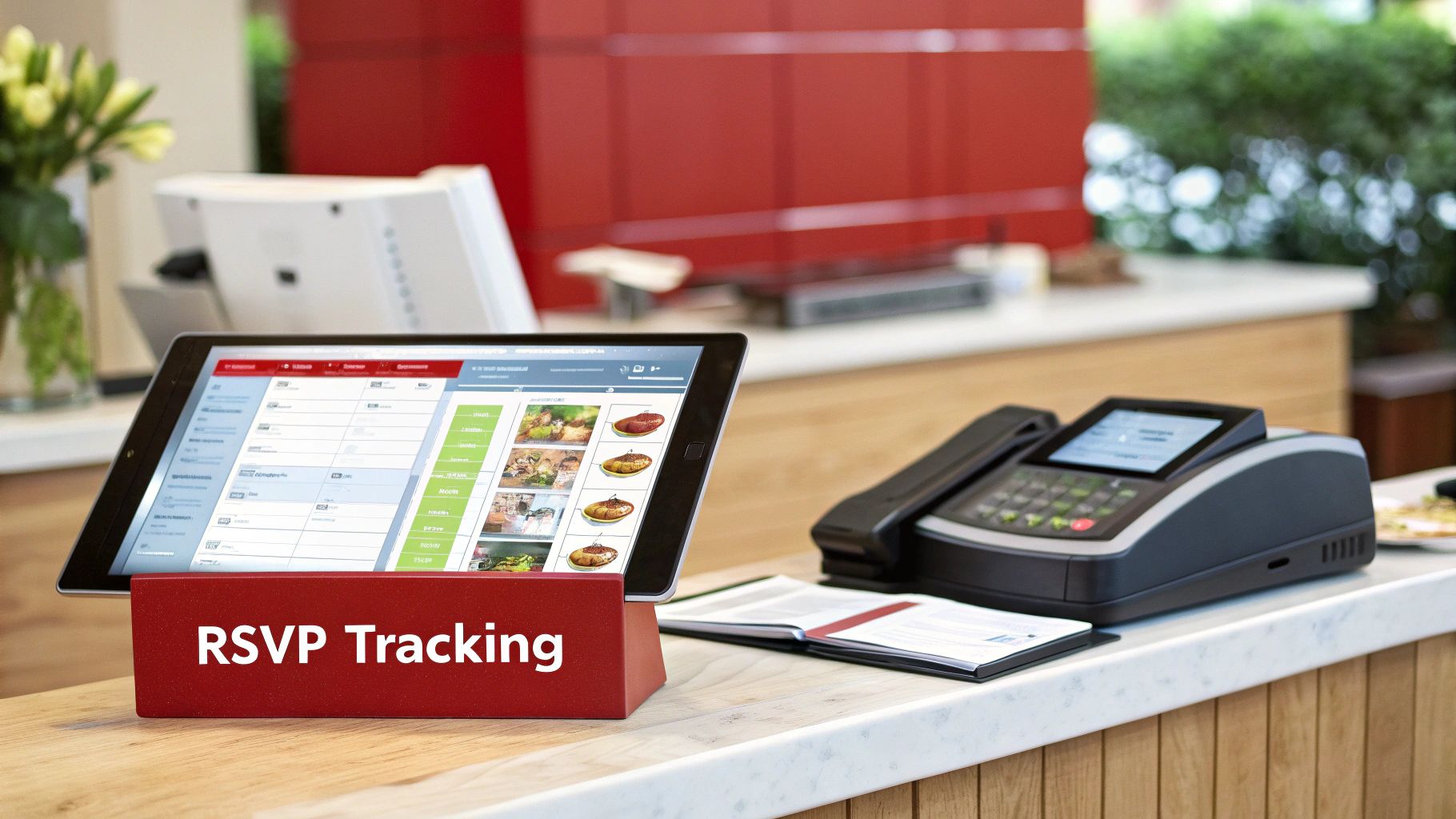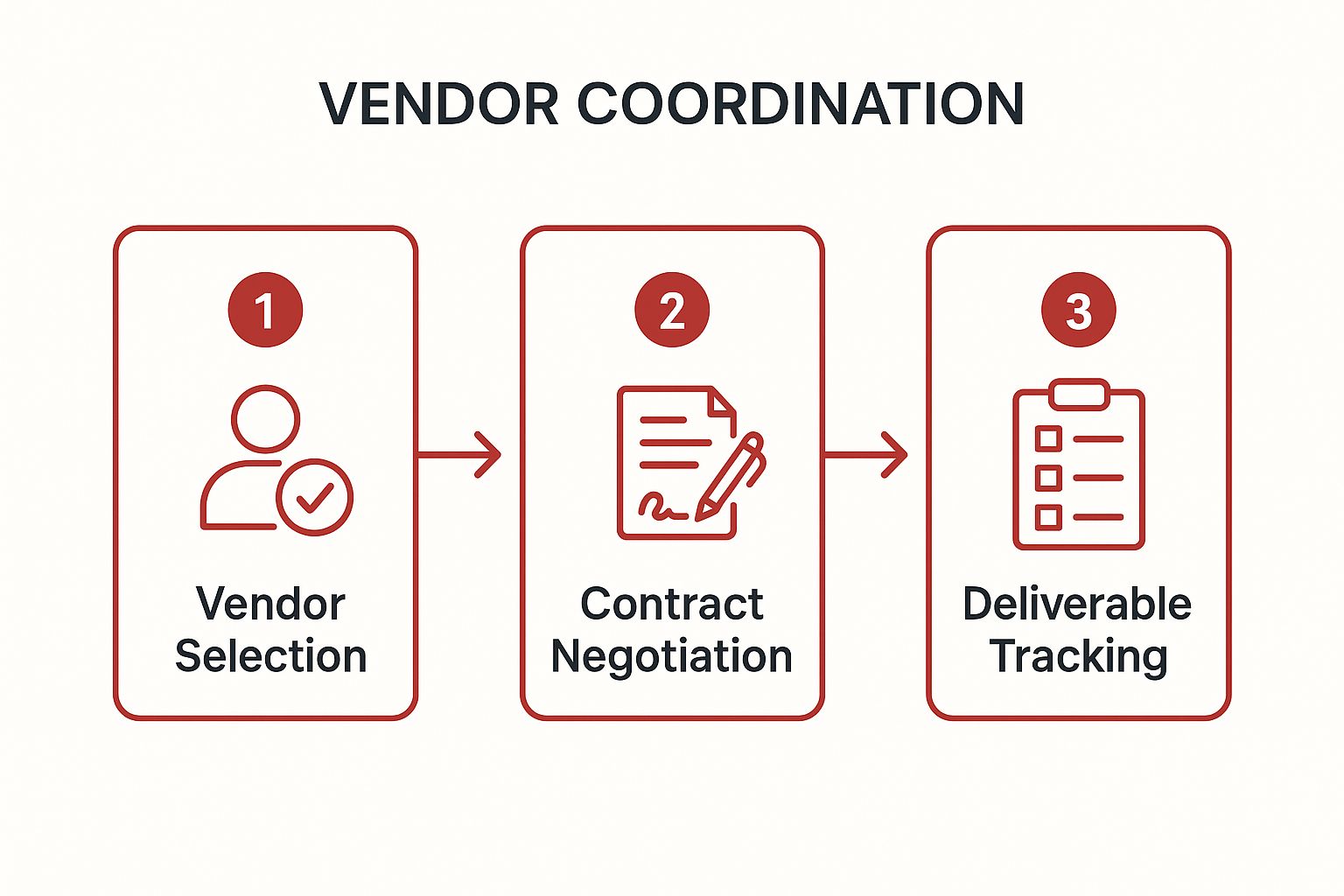Unlock Flawless Events: Your Guide to the Best Planning Templates
Planning a high-stakes corporate conference, a dynamic startup launch, or an exclusive investor summit involves managing an immense number of details. The key to executing a seamless, successful event is meticulous organization, which begins with a powerful event planning checklist template. This foundational tool acts as a central command center, preventing critical tasks from being overlooked, from initial budget forecasting to post-event performance analysis.
The challenge is that many templates are too generic to be truly useful, while others are so niche they lack flexibility. This guide cuts through the clutter. We have curated a definitive resource list focusing on the eight most critical components of event management. For each component, we will analyze top-tier templates, breaking down their practical applications, specific features, and honest limitations. You will learn how to select and adapt the right frameworks for venue logistics, vendor contracts, risk management, and more. This isn't just a list; it's a strategic playbook to help you master every phase of the event lifecycle and ensure your next corporate gathering is a measurable success.
1. Event Budget Planning and Financial Management
Before a single guest is invited or a venue is booked, the most critical component of any successful event plan is a robust financial strategy. Event budget planning is the foundational process of estimating all potential costs, allocating funds to specific categories like venue, catering, and marketing, and meticulously tracking every dollar spent. This isn't just about listing expenses; it's a dynamic system for financial control that ensures your event meets its objectives without exceeding its fiscal boundaries. A well-structured budget serves as the primary decision-making tool throughout the entire event lifecycle.

Why It's a Top Priority
This element earns its number one spot because without a sound budget, even the most creative event concept is destined for failure. It directly impacts every other decision in your event planning checklist template, from the quality of the speakers you can afford to the technology you can implement. For corporate events, it demonstrates fiscal responsibility to stakeholders, while for large-scale festivals, it's the key to profitability. Ignoring this step leads to scope creep, last-minute financial crises, and potential damage to your brand's reputation.
Implementation and Best Practices
Successful implementation requires a granular approach. Instead of a single "entertainment" line item, break it down into "keynote speaker fee," "band travel costs," and "stage lighting rental." This level of detail provides clarity and control.
- Create Tiered Projections: Develop best-case, worst-case, and most-likely budget scenarios. This is especially useful for tech startups planning product launches where attendee numbers can vary significantly.
- Incorporate a Contingency Fund: Always allocate 15-20% of your total budget to a contingency fund. This buffer is non-negotiable and covers unforeseen costs, like a last-minute equipment rental or unexpected shipping fees.
- Leverage Technology: Use event management software with integrated budget-tracking features. These tools automate expense logging and provide real-time dashboards, allowing for proactive adjustments rather than reactive damage control. For a comprehensive breakdown, you can learn more about how to create a detailed financial framework with our event budget planning template.
- Regularly Review and Reconcile: Schedule weekly budget meetings to review actual spending against your projections. This frequent check-in helps you catch overages early and reallocate funds from other areas if necessary.
2. Venue Selection and Logistics Coordination
After establishing your financial framework, the physical space where your event will unfold becomes the next crucial decision. Venue selection and logistics coordination is the comprehensive process of identifying, evaluating, and securing the perfect location for an event. It extends beyond just the four walls to include detailed logistics planning for setup, accessibility, capacity management, and technical requirements. This involves meticulous site visits, shrewd contract negotiations, and seamless coordination with venue staff to ensure the environment perfectly aligns with your event’s goals and brand identity.

Why It's a Top Priority
The venue is more than a backdrop; it’s an integral part of the attendee experience and a core component of your event's identity. The right choice can elevate your event, while the wrong one can create insurmountable logistical nightmares. For a tech company launching a groundbreaking product, a unique venue like a modern art museum can amplify the message of innovation. For corporate conferences, a venue with integrated AV capabilities and breakout rooms is non-negotiable for productivity. This element is high on the event planning checklist template because it directly impacts budget, branding, and operational feasibility.
Implementation and Best Practices
Successful venue selection requires a forward-thinking and detailed approach. It's about envisioning the entire event flow within the space, from guest arrival to departure. When navigating the complexities of Venue Selection and Logistics Coordination, a comprehensive checklist can be an invaluable tool. For more specific guidance, consider this resource on an Event Venue Checklist: Essential Aips for a Successful Event.
- Conduct In-Person Site Visits: Always visit your top venue choices in person, ideally at the same time of day your event will take place. This helps you assess natural lighting, traffic patterns, and the general ambiance.
- Test All Technical Aspects: During the visit, thoroughly test the Wi-Fi strength, cellular reception in key areas like presentation halls and basements, and the capacity of the electrical system.
- Clarify Logistical Procedures: Get written confirmation of all load-in and load-out times, access points for vendors, and any union labor requirements. Surprises in this area can lead to significant cost overruns.
- Document Everything: Every specification, from room setup diagrams to agreed-upon staffing levels, must be documented in the contract. Verbal agreements are unreliable and can cause major issues on event day.
3. Guest Management and RSVP System
Beyond simply sending invitations, a sophisticated guest management and RSVP system is the central nervous system for attendee engagement. This process encompasses everything from the initial invitation and response tracking to managing dietary needs, seating arrangements, and post-event communications. It's an integrated system designed to ensure accurate headcounts, facilitate seamless check-ins, and deliver a personalized, high-touch experience for every attendee, which is a critical part of any comprehensive event planning checklist template. A robust system transforms a simple list of names into a dynamic database for strategic engagement.

Why It's a Top Priority
This element is vital because inaccurate guest data can have a catastrophic domino effect on your event. An unreliable headcount leads to overspending on catering or, worse, running out of food. It impacts venue capacity, material printing, and staffing levels. For corporate conferences or product launches, a poor check-in experience creates a negative first impression. Effective guest management, powered by tools like Cvent or Eventbrite, ensures every touchpoint is smooth, professional, and tailored, directly reflecting on your brand's operational excellence.
Implementation and Best Practices
Successful guest management relies on automation and clear communication protocols. The goal is to collect necessary data with minimal friction for the attendee, making the process feel effortless and exclusive.
- Segment Your Guest Lists: Don't use a one-size-fits-all approach. Create distinct lists for VIPs, speakers, media, and general attendees to tailor communication and offer different registration paths or perks.
- Automate Reminders and Updates: Schedule automated reminder emails to go out two weeks and one week before the RSVP deadline. Use the system to send important updates, like a change in speakers or venue logistics, to all confirmed guests simultaneously.
- Plan for a Hybrid Check-In: While QR codes and mobile app check-ins are efficient, always have a manual, low-tech backup. A tablet with a searchable spreadsheet or even a printed list can prevent chaos if technology fails or a guest forgets their ticket.
- Collect Actionable Data: Use the registration form to gather more than just a name. Include fields for dietary restrictions, accessibility needs, and consent for marketing communications. This data allows for personalization and demonstrates thoughtful planning.
4. Vendor Coordination and Contract Management
Beyond the core concept and budget, the success of an event hinges on the quality and reliability of its third-party partners. Vendor coordination and contract management is the strategic process of identifying, vetting, contracting, and managing all service providers. This encompasses everything from caterers and photographers to entertainment acts and technical support crews. It's a complex logistical function that involves aligning multiple independent timelines, ensuring consistent quality, and having robust contingency plans for any vendor-related issues that may arise.
This infographic outlines the core sequential flow of effective vendor management.

Following this structured process transforms vendor relationships from a potential liability into a strategic asset for your event.
Why It's a Top Priority
This element is crucial because your vendors are the public-facing and operational extension of your event's brand. A single failure, a late caterer, a malfunctioning AV system, or an unprofessional photographer, can undermine the entire attendee experience. For large-scale corporate conferences, robust vendor management ensures a seamless and professional execution that reflects positively on the company. In the luxury wedding market, where expectations are sky-high, it's the meticulous coordination of a trusted network of vendors that creates a flawless, high-end experience. Without this focus, you risk logistical chaos, contractual disputes, and brand damage.
Implementation and Best Practices
Effective implementation goes far beyond simply hiring the first available provider. It requires due diligence, clear communication, and legally sound agreements to protect your interests and guarantee performance.
- Create Detailed Run-of-Show Documents: Provide every vendor with a master schedule that details their specific call times, setup requirements, performance windows, and strike procedures. This single source of truth prevents confusion and misalignment.
- Establish Backup Vendors: For critical services like power, AV, and catering, you must identify and pre-vet backup vendors. This contingency is non-negotiable for high-stakes events and is a core part of any professional event planning checklist template.
- Schedule a Final Walk-Through: Hold a mandatory coordination meeting or site visit with all key vendors approximately two weeks before the event. This allows you to resolve any last-minute logistical hurdles and ensure everyone understands their role in the overall production.
- Scrutinize Contracts: Never sign a standard vendor agreement without a thorough review. Pay close attention to cancellation policies, liability insurance, force majeure clauses, and specific deliverables. Add amendments that explicitly define substitution rights and performance standards.
5. Timeline and Schedule Development
Beyond the budget, the event timeline is the master blueprint that orchestrates every moving part of your event. Timeline and schedule development involves creating a comprehensive, reverse-engineered plan that maps out every task, deadline, and dependency from the earliest planning stages to the final post-event report. This isn't just a simple to-do list; it's a dynamic, strategic document that coordinates all vendor deliverables, logistical requirements, and internal team responsibilities, ensuring that every element comes together in perfect sync.
Why It's a Top Priority
This element is crucial because it transforms a chaotic collection of tasks into a structured, manageable workflow. A well-executed timeline is the difference between a seamless, professional production and a last-minute scramble. For complex events like tech product launches or multi-day conferences, it ensures that critical path activities, like securing keynote speakers and finalizing venue contracts, are completed on schedule, preventing costly downstream delays. An effective schedule in your event planning checklist template is the ultimate tool for risk mitigation and quality control.
Implementation and Best Practices
Successful implementation hinges on meticulous detail and a forward-thinking approach. The process begins by establishing the event date and working backwards, plotting every necessary action along the way. This method, popularized by figures like Martha Stewart and codified by the Project Management Institute (PMI), ensures no detail is overlooked.
- Work Backwards from a Fixed Date: Start with your event day and map out all deadlines in reverse chronological order. This identifies critical milestones and reveals the true lead time required for tasks like venue booking or custom merchandise production.
- Build in Buffer Time: Just like a financial contingency, a temporal buffer is non-negotiable. Allocate an additional 15-20% of time to critical activities to absorb unexpected delays, such as shipping issues or longer-than-expected content approval cycles.
- Use Project Management Software: Leverage tools with dependency tracking and Gantt chart features. This allows you to visualize how a delay in one area, like graphic design, directly impacts subsequent tasks, such as printing marketing materials.
- Create Role-Specific Timelines: Develop separate, simplified timelines for different stakeholders (e.g., vendors, speakers, marketing team). This provides clarity without overwhelming individuals with irrelevant information. For specialized timelines, particularly for online gatherings, you can find a dedicated framework with our virtual event checklist.
6. Marketing and Promotion Strategy
Once your event's core components are in place, the focus must shift to creating awareness and driving attendance. A marketing and promotion strategy is the comprehensive plan for communicating your event's value to a target audience. It goes beyond simply announcing dates; it involves building a brand narrative, creating compelling content, and executing multi-channel campaigns designed to generate excitement and secure registrations. This strategic approach ensures your message reaches the right people at the right time, transforming potential interest into committed attendees.
Why It's a Top Priority
This element is crucial because a brilliantly planned event is meaningless without an audience. An effective marketing plan is what fills the seats, whether virtual or physical, and ultimately determines the event's reach and impact. For corporate product launches, it builds market anticipation and drives early adoption. For industry conferences like SXSW, it’s what creates a global conversation and sells out tickets months in advance. A weak promotional effort is a direct path to a low-turnout, low-energy event that fails to meet its primary objectives.
Implementation and Best Practices
Successful promotion requires a blend of creativity, data, and consistent execution. Start by defining your ideal attendee and tailoring your messaging and channel selection to reach them effectively. A robust marketing section is a non-negotiable part of any high-level event planning checklist template.
- Develop a Content-Driven Campaign: Create valuable content like blog posts, speaker interviews, or behind-the-scenes videos that offer a taste of the event's value. This builds a relationship with your audience long before they register.
- Implement a Promotional Timeline: Launch marketing efforts 6-8 weeks prior to the event, using early-bird discounts to create urgency. To streamline your marketing efforts and boost engagement, consider implementing a comprehensive social media calendar template.
- Leverage Multi-Channel Outreach: Don't rely solely on one platform. Combine email marketing, paid social ads, organic social media, PR outreach, and partnerships to create a surround-sound effect that captures your audience's attention.
- Activate Influencer and Partner Marketing: Collaborate with industry influencers and event partners to tap into their established audiences. Their endorsement provides powerful social proof that can significantly boost credibility and registration numbers. To get started, you can explore some of these top promotional event ideas.
7. Risk Management and Contingency Planning
Beyond logistics and budgets lies the critical practice of preparing for the unexpected. Risk management is the systematic process of identifying, assessing, and mitigating potential threats that could derail your event. It involves developing proactive strategies and backup plans to handle everything from minor technical glitches to major emergencies. A comprehensive contingency plan is not a sign of pessimism; it is the hallmark of a professional, resilient event strategy that protects your investment, attendees, and brand reputation.
Why It's a Top Priority
This element is crucial because no event is immune to potential disruptions. From a keynote speaker missing a flight to a sudden power outage, a single unforeseen issue can cascade into a full-blown crisis without a plan. For large-scale corporate conferences or outdoor festivals, a robust risk management framework is non-negotiable for ensuring guest safety and fulfilling legal obligations. Integrating this into your event planning checklist template demonstrates foresight to stakeholders and provides your team with the confidence to handle any challenge that arises.
Implementation and Best Practices
Effective implementation goes beyond a simple "what if" list; it requires detailed, actionable protocols that can be deployed instantly. The goal is to move from a reactive panic mode to a controlled, professional response.
- Conduct a Risk Assessment Workshop: Gather key team members and stakeholders to brainstorm all possible risks, categorizing them by likelihood and potential impact. This helps prioritize which scenarios, like severe weather for an outdoor event, need the most detailed mitigation plans.
- Develop Specific Response Protocols: Create clear, step-by-step action plans for your top 5-10 identified risks. For example, a "vendor no-show" protocol should include a pre-vetted backup vendor list with contact information and pre-negotiated emergency rates.
- Establish a Communication Tree: Design a clear crisis communication hierarchy. Who is the designated spokesperson? How will you disseminate information to staff, volunteers, and attendees (e.g., via a mobile app push notification, SMS alert, or on-site announcements)?
- Secure Appropriate Insurance: Consult with an insurance professional to ensure you have adequate coverage, including general liability, cancellation, and potentially specialized policies like weather insurance. This financial safety net is a cornerstone of responsible event management.
8. Post-Event Analysis and Follow-up
The conclusion of an event doesn't signify the end of the planning cycle; it marks the beginning of a crucial evaluation phase. Post-event analysis is the systematic process of assessing performance against objectives, gathering comprehensive feedback, and calculating the true return on investment (ROI). This stage involves everything from final financial reconciliation and attendee satisfaction surveys to stakeholder debriefs and strategic follow-up communications. It transforms a one-time gathering into a valuable data asset that directly informs and improves all future event strategies.
Why It's a Top Priority
This final step is what separates amateur event coordinators from professional strategists. Without a formal post-event process, you lose the opportunity to prove an event’s value, learn from mistakes, and capitalize on the momentum generated. For corporate marketing teams, this analysis provides the hard data needed to justify budget allocation for future initiatives. For tech conferences, it’s how the agenda for the next year is shaped based on attendee interests. Neglecting this part of your event planning checklist template means you are essentially starting from scratch every single time.
Implementation and Best Practices
A structured follow-up plan ensures no valuable insight is lost. The key is to act quickly while the experience is still fresh in everyone's mind.
- Deploy Surveys Immediately: Send feedback surveys within 24-48 hours of the event's conclusion. Incentivize completion with a small gift, exclusive content, or a discount on future events to maximize response rates.
- Schedule a Prompt Debrief: Hold a post-mortem meeting with all key staff, vendors, and stakeholders within one week. Use a standardized agenda to discuss what worked, what didn't, and actionable steps for improvement.
- Analyze Key Performance Indicators (KPIs): Go beyond simple attendance numbers. Analyze metrics like lead conversion rates for exhibitors, social media engagement levels, and session popularity to get a holistic view of success.
- Formalize Financial Reconciliation: Conduct a final, thorough review of the budget, comparing projected costs against actual expenditures. This final report is critical for demonstrating fiscal responsibility and informing the next event's financial framework. To discover more about maximizing your event's impact, review our guide on business event planning strategies.
8-Point Event Planning Checklist Comparison
| Event Planning Aspect | Core Features / Characteristics | User Experience / Quality ★★★★☆ | Value Proposition 💰 | Target Audience 👥 | Unique Selling Points ✨ | Price Points 💰 |
|---|---|---|---|---|---|---|
| Event Budget Planning and Financial Management | Detailed budget breakdown, real-time expense tracking, ROI tools | ★★★★☆ Prevents overspending, accountability | Transparent budgeting, cost control | Corporate, weddings, festivals | Free setup/proofs, contingency fund | 💰 Moderate (time investment) |
| Venue Selection and Logistics Coordination | Capacity & floor plans, accessibility, tech infrastructure | ★★★★☆ Enhances guest experience | Cost savings via package deals | Tech launches, weddings, conferences | Backup venue planning, contract negotiation | 💰 Variable (venue dependent) |
| Guest Management and RSVP System | Automated RSVPs, dietary & accessibility management | ★★★★☆ Streamlined check-in and personalized guest care | Accurate headcount, communication ease | Corporate, weddings, conferences | Contactless QR check-in, automated reminders | 💰 Moderate |
| Vendor Coordination and Contract Management | Vendor database, contract tools, milestone tracking | ★★★★☆ Professional delivery, clear accountability | Competitive bidding, quality control | Weddings, corporate events, festivals | Backup vendors, detailed run-of-show | 💰 Time-intensive |
| Timeline and Schedule Development | Master timeline, critical path, buffer times | ★★★★☆ Smooth execution, conflict avoidance | Accountability, proactive management | Large events, weddings, trade shows | Dependency tracking, minute-by-minute schedule | 💰 Moderate |
| Marketing and Promotion Strategy | Multi-channel campaigns, social media automation | ★★★★☆ Boosts attendance and engagement | Brand awareness, measurable ROI | Event organizers, brands | Influencer partnerships, content calendar | 💰 Variable (campaign scale) |
| Risk Management and Contingency Planning | Risk matrices, backup plans, insurance, emergency protocols | ★★★★☆ Minimizes disruptions, peace of mind | Prevents losses, professional preparedness | Outdoor events, corporate conferences | Vendor backups, crisis communication plans | 💰 Additional budget needed |
| Post-Event Analysis and Follow-up | Performance metrics, feedback collection, ROI calculation | ★★★★☆ Data-driven improvements, relationship building | Maximizes ROI, accountability | Corporate, weddings, trade shows | Automated surveys, lead nurturing workflows | 💰 Time and effort required |
From Checklist to Reality: Executing Your Perfect Event
We've explored a comprehensive array of templates, each designed to tackle a specific facet of the event lifecycle. From the meticulous financial tracking in budget planners to the intricate scheduling of a master timeline, the core takeaway is clear: a generic to-do list is simply not enough. The true power lies in selecting and customizing an event planning checklist template that serves as a dynamic, strategic blueprint for your specific occasion, whether it's a high-stakes corporate summit for a Fortune 100 company or an innovative product launch for a tech startup.
The most effective event coordinators understand that these templates are not rigid instruction manuals but foundational frameworks. The real magic happens when you adapt them. A venue logistics checklist for a multi-day conference will have vastly different dependencies than one for a single-evening gala. Similarly, a risk management plan for an outdoor festival requires a completely different set of contingencies compared to an indoor shareholder meeting. The key is to use the structures we've discussed as a starting point, integrating your unique brand voice, audience expectations, and strategic objectives into every line item.
Turning Strategy into Flawless Execution
Successfully executing your event and translating your checklist into a memorable reality often hinges on applying proven project management best practices. Think of each major event component, like vendor coordination or marketing promotion, as a mini-project within the larger initiative. This mindset shift encourages a more structured approach to delegation, resource allocation, and communication, ensuring that no detail, no matter how small, slips through the cracks. It's this disciplined execution that separates a good event from an unforgettable one.
Ultimately, mastering the use of a detailed event planning checklist template empowers you to move beyond reactive problem-solving and into proactive, strategic leadership. You are no longer just checking boxes; you are architecting an experience. This structured approach frees up valuable mental bandwidth, allowing you to focus on what truly matters: creating moments of connection, delivering impactful content, and achieving your core business goals. The result is a seamless, professional event that not only runs flawlessly but also resonates deeply with your attendees, reinforcing your brand's reputation for quality and excellence. Your checklist is the critical first step on the path from a great idea to a tangible, successful reality.
To leave a lasting impression that extends well beyond the closing remarks, consider how your brand can remain part of your attendees' daily lives. High-quality, bespoke corporate gifts are a powerful tool for building enduring brand affinity. For a truly premium touch, explore custom-branded tech from Electronic Finishing Solutions to create memorable, high-value promotional items that reflect your company's commitment to innovation and excellence.



